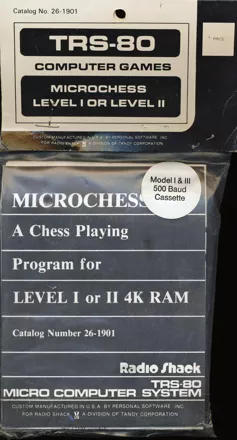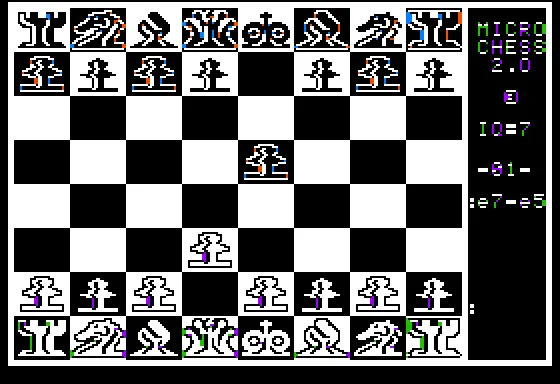Microchess
Description
Microchess, a chess-playing program for microcomputers, has been described as the first commercially successful game for home computers, initially programmed in 1976 on MOS Technology's KIM-1.
Designed for homebrew kit hobbyists to plug into less than 1k of memory, what the play algorithms lack in grandmaster talent they make up for in speed. Marginally upgraded (the TRS-80 version expanded to 4k: 2k for game logic and 2k for a picture of a chess board) for the burgeoning microcomputer market (why restrict input and output to a hex keyboard and 6 LED digit displays if you don't have to?) it went on to sell over a million copies for the Apple 2 and TRS-80 (and, among the usual suspects, also eventually ported to other hobby platforms such as those made by "Processor Technology, Imsai, Cromemco, Polymorphic Systems, MITS, Ohio Scientific, and many more") before quickly being overtaken by the likes of Sargon.
Groups +
Screenshots
Promos
Credits (Intel 8080 version)
| Written by |
|
Reviews
Critics
Players
Average score: 3.0 out of 5 (based on 15 ratings with 1 reviews)
The Good
The first thing that impressed me about this chess game was the ease of use, & clear display, which was good for an early game of this period. To play it is important to have a copy of the manual handy, as there are a couple of commands that are not obvious without it. There are 8 levels available, with the first two very easy, & I managed to beat level 4 after a bit, although I am not renowned for my great chess skills. The graphics, although black/white are clear, & it is easy to see what the pieces are.
The Bad
If you haven't got a manual handy you could be in trouble, as for some reason the default is on level 8, & if you don't know how to change it, you have the impression the game is really hard. I would also have liked a replay a go command, as there was a couple of times I moved without meaning to do so, & there was no way back.
The Bottom Line
There is no real reason to play ancient board games, unless obscure, due to the amount of free modern versions, but if you do for nostalgia sake & are looking for an early Apple II example, this is as good as any. Choice of levels, clear graphics & display, & easy to pick up and play, make this a good choice. The author 'Peter Jennings' made this version available for a variety of early machines in the late 70's, which were well respected at the time. Nice to play.
Apple II · by zorkman (132) · 2015
Trivia
Royalties
Peter Jennings postponed collecting royalties from Personal Software's booming sales of Microchess, in effect loaning the company the money it needed to cross-compile its next product on a time-share system. This application was VisiCalc, the first home computer spreadsheet (and "killer app"); selling over a million copies at hundreds of (1980s) dollars a pop, Jennings got a good return on his investment.
Electronic board version
BYTE Magazine volume 4 number 9 (September 1979) featured an article, including modified source code, to build a version of the game that could be played using a physical chess board with an electronic circuit hooked up to a KIM-1 computer. The AI's moves are indicated by LED lights integrated into the physical board.
Analytics
Upgrade to MobyPro to view research rankings!
Related Sites +
-
Microchess manual
Not only the instructions but the product: following the usual manual instructions are 15 pages of user-input source code. -
The Microchess story
An account-in-progress of the rise and fall of the first blockbuster home computer game
Identifiers +
Contribute
Are you familiar with this game? Help document and preserve this entry in video game history! If your contribution is approved, you will earn points and be credited as a contributor.
Contributors to this Entry
Game added by Pseudo_Intellectual.
Intel 8080, KIM-1, Sol-20 added by Kabushi. Ohio Scientific, Zilog Z80, Apple I, Interact Model One, Dedicated console added by vedder.
Additional contributors: formercontrib, vedder, Patrick Bregger.
Game added August 15, 2007. Last modified August 3, 2024.















